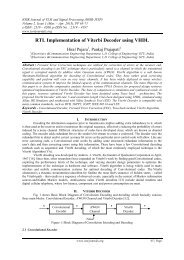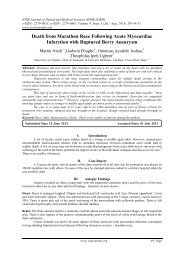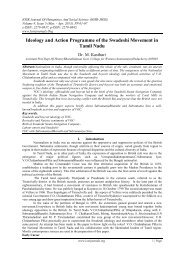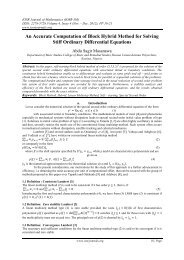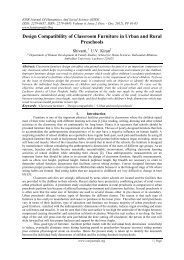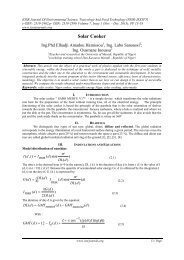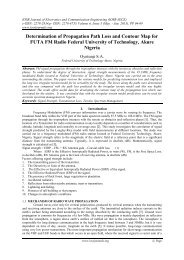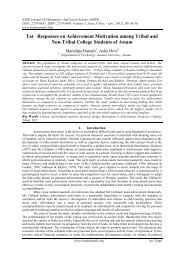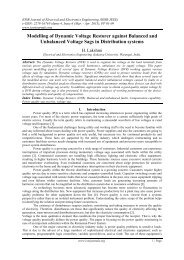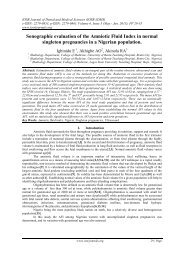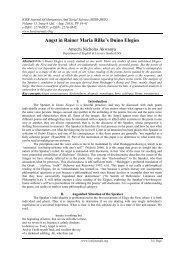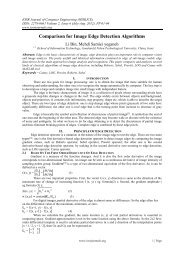Initial Conquest of India by Turks and Their Slaves - IOSR
Initial Conquest of India by Turks and Their Slaves - IOSR
Initial Conquest of India by Turks and Their Slaves - IOSR
You also want an ePaper? Increase the reach of your titles
YUMPU automatically turns print PDFs into web optimized ePapers that Google loves.
<strong>Initial</strong> <strong>Conquest</strong> Of <strong>India</strong> By <strong>Turks</strong> And <strong>Their</strong> <strong>Slaves</strong><br />
numbers. The Qarlugh <strong>Turks</strong> or „Qarakhanids‟(who may still have been claiming Ashina Descent) were the first<br />
to undergo almost complete sedentarization, after moving into Farghana, an area which in the ninth century was<br />
gradually becoming Islamicized. The Qarlughs established capitals at Kashgar in Sinkiang <strong>and</strong> Balasaghum in<br />
the valley <strong>of</strong> the Chu river. <strong>Their</strong> rulers converted to Islam after the middle <strong>of</strong> the tenth century, <strong>and</strong> in 961 A.D.<br />
This was followed <strong>by</strong> the conversion <strong>of</strong> some 100,000 Turkish „Tents‟ in the area. More precise <strong>and</strong> reliable<br />
knowledge emerged among the Muslims <strong>by</strong> the ninth century, when the Samanids extended the frontier along<br />
the Syr Darya <strong>and</strong> <strong>Turks</strong> began to enter the Caliphate as military slaves.<br />
There do not appear to have been any Turkish invasion on the North-western frontier or elsewhere, <strong>and</strong><br />
we do not hear at all <strong>of</strong> Muslim <strong>Turks</strong> in al-Hind, before the late tenth <strong>and</strong> eleventh century.If we could identify<br />
various groups from central Asia which migrated into the subcontinent in earlier times, these were not the<br />
Turkish. The first real evidence <strong>of</strong> <strong>Turks</strong> in al-Hind comes from Kashmir during Lalitaditya Muktapida‟s reign.<br />
This king, while extending his powers into central Asia, is recorded to have recruited soldiers from the western<br />
Central-Asian highl<strong>and</strong>s <strong>and</strong> Tukharistan. Al-Biruni has recorded that the people <strong>of</strong> Kashmir celebrated an<br />
annual festival to commemorate the victory <strong>of</strong> their king Muttai (Muktapida) over the <strong>Turks</strong>. <strong>India</strong>n vernacular<br />
sources describe the conquest at length as „The opening <strong>of</strong> the gates <strong>of</strong> Hind‟.<br />
While inscriptions in sanskrit which survived from these centuries frequently mention the violent<br />
erruptions <strong>of</strong> the Turushkas, the „Country Conquering <strong>Turks</strong>‟ , „Beef-eating barbarians (mlecchas)‟ , „Shaka<br />
princes‟ , or at a somewhat later stage, <strong>of</strong> the „Mongols‟ (Mudgalas). To piece together a coherent narrative to<br />
the conquest, however , from the late tenth to the early thirteenth century, would be impossible on the basis <strong>of</strong><br />
the <strong>India</strong>n materials alone. It is disconcertingly difficult even with the aid <strong>of</strong> the Arabic <strong>and</strong> Persian sources. The<br />
latter however, on the most basic level, deal with sequences <strong>of</strong> events (rather than individual events), <strong>and</strong> they<br />
allow us to distinguish two stages in the conquest: the first, commonly called, The Ghaznavid Period, from 977<br />
to 1186 A.D. ; <strong>and</strong> the second, The Ghurid Period, from 1186 to 1206 A.D.<br />
Mahmuds dynasty, The Ghaznavids or Yaminids (352-582/962-1186), was a Turkish stock; its<br />
effective founder, Mahmuds father Sabüktagin, had been a Turkish slave comm<strong>and</strong>er. At its greatest extent, the<br />
Ghaznavid empire embraced an area from Rayy <strong>and</strong> Isfahān in Persia as far as Hānsi in the eastern Punjab.<br />
Mahmud himself, who conducted no less than seventeen expeditions against Pagan <strong>India</strong>n rulers <strong>and</strong> who also<br />
rooted out the Ismailis from the cities <strong>of</strong> Multan <strong>and</strong> Mansura, was rewarded <strong>by</strong> the „Abbasid Caliph for his<br />
services to Sunni Islam with the laqab <strong>of</strong> Yamin-al-Dawla‟(“Right H<strong>and</strong> <strong>of</strong> the State”). The main concern <strong>of</strong> the<br />
Ghaznavid <strong>Turks</strong>, from the beginning, appears to have been to penetrate into the major river valleys, <strong>of</strong> the<br />
Indus first,then the „Five River L<strong>and</strong> <strong>of</strong> Punjab‟ <strong>and</strong> finally the „Two River L<strong>and</strong>-The Ganga-Yamuna<br />
Doab‟.The very earliest expansion towards east,into al-Hind began under Alptagin, in the period 933-963 A.D.,<br />
when his general Sabuktagin raided Lamghan <strong>and</strong> Multan.<br />
In the first year <strong>of</strong> his reign, in 977-8 A.D.,Sabuktagin also conquered Bust, the second most important<br />
fortified city in Sijistan (after Zaranj).Qusdar, another fortified Muslim town in Turan (Sind), which gave its<br />
name to an entire sub region, fell to the Ghaznavid in the same year <strong>and</strong> then the entire province <strong>of</strong> Q<strong>and</strong>har. On<br />
a third occasion,in 991 A.D,the assembled army <strong>of</strong> a coalition <strong>of</strong> <strong>India</strong>n Kings headed <strong>by</strong> the Hindu Shahi was<br />
dispersed, after which Ghaznavid power was established in virtually all areas <strong>of</strong> the west <strong>of</strong> the Indus.<br />
Sabuktagins son <strong>and</strong> successor Mahmud (r.998-1030), obtaining caliphal sanction (mauqif-i-Khilafat) for his<br />
actions, exp<strong>and</strong>ed the Ghaznavid empire as far as the Caspian Sea, <strong>and</strong> from Samarq<strong>and</strong> to Ray, while invading<br />
Hind about seventeen times <strong>and</strong> ultimately establishing permanent control over the Punjab. During renewed<br />
campaining into Lamghan, <strong>and</strong> to Peshawar (Ar. Parshawar), Waihind, on the road from Peshawar to Lahore,<br />
was taken from the Hindu Shahi. In 1004-05 followed the conquest <strong>of</strong> Bhatinda or Tabarhind,which,together<br />
with Bhatnair, Sirsa <strong>and</strong> Abahr,was one <strong>of</strong> the four important forts in the path <strong>of</strong> any invader from the North-<br />
West, <strong>and</strong> had to be reduced in order to gain access to the trans-Gangetic plain. Nagarkot (Bhima Naghara) was<br />
taken in 1008, <strong>and</strong> again Waihind. Much further inl<strong>and</strong> (Al-Utbi says in the middle <strong>of</strong> al-Hind). The capture <strong>of</strong><br />
Narayan (present Narayanpur, near Alwar,Rajasthan) appears to have been aimed at gaining another route <strong>of</strong><br />
access to the Ganges- Yamuna Doab.Similarly, Nardin (N<strong>and</strong>ana, N<strong>and</strong>una) on the northern spur <strong>of</strong> the salt<br />
range in the Jud hills, still in the h<strong>and</strong>s <strong>of</strong> a Hindu Shahi subordinate, was taken to gain comm<strong>and</strong> over the main<br />
route to the Doab,‟the most glorious victory <strong>of</strong> islam since the time <strong>of</strong> the Prophet. When the Turkish armies,<br />
after opening these gates, finally broke through to the middle country, the Temple City <strong>of</strong> Thaneswar (Ar.<br />
Tanisar, Tanishar), to the north <strong>of</strong> Delhi, was destroyed first, probably in 1011 (The city was entered<br />
unopposed), then Mathura (Matra, Mahura, Matura)(also entered without opposition), on the Yamuna, then the<br />
capital city,Kanauj (Qanauj, Qannauj), which was still governed <strong>by</strong> a Pratihara ruler that Al-Utbi refers to as<br />
„The pre-eminent <strong>India</strong>n King‟ (muqaddam-i-muluk-i-hind). Mahmud returned to Ghazna after this, but in the<br />
fall <strong>of</strong> the same year 1019 crossed the Yamuna again,<strong>and</strong> now possibly for the first time,the Ganges, in attack on<br />
the Ch<strong>and</strong>ellas, <strong>by</strong> that time the most powerful rulers <strong>of</strong> the North <strong>India</strong> in Jejakabukti (Bundelkh<strong>and</strong>),<br />
Khajuraho, <strong>and</strong> Gwalior. Lahore was taken without opposition some year later. The forts <strong>of</strong> Kalanjar <strong>and</strong><br />
Gwalior (Gwaliyar) were taken from the Ch<strong>and</strong>ella ruler in 1022-3. Somnath the wealthy harbor <strong>and</strong> pilgrimage<br />
www.iosrjournals.org<br />
2 | Page



